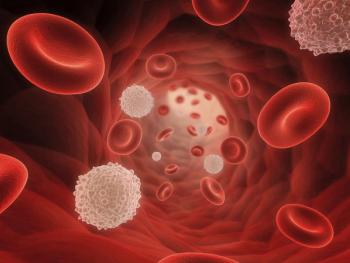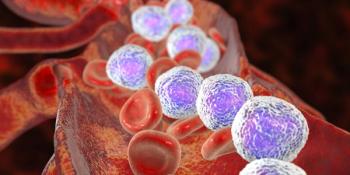
Updates in Therapies of Relapsed and Refractory Follicular Lymphoma
In this CancerNetwork® OncView™ program, faculty panelist Connie Batlevi, MD, PhD, explains the treatment options in this disease space and discusses a recent drug approval.
In a recent OncView™ discussion, Connie Lee Batlevi, MD, PhD, a medical oncologist focused on the treatment of Hodgkin and non-Hodgkin lymphomas at Memorial Sloan Kettering Cancer Center in New York, shared clinical experiences and perspectives regarding treatments in the follicular lymphoma space.
To begin the discussion, Batlevi said the risk of disease relapse in this population is high, and it is increasing as patients are living longer. “Follicular lymphoma is considered a noncurable indolent lymphoma,” she explained. “The goal of any treatment is to balance effectiveness of treatment, quality of life, and cost of care. In some longitudinal studies, about 50% of patients relapse after frontline therapy [with] more than a decade of observation. However, as patients are thankfully living beyond a decade, we know that patients are ultimately always at risk for a relapse.”
Batlevi detailed her rationale for therapy selection at each relapse and considerations for sequencing agents in this patient population.
Therapy Selection Considerations at Each Relapse
According to Batlevi, factors that may play into treatment selection at first relapse include a patient’s functional status, characteristics of their disease at relapse, disease volume on imaging, laboratory findings, metabolic activity on PET scan, and genetic and pathologic assessments.
“A biopsy is almost always an important aspect of disease assessment because it is key to identifying a transformation. If a transformation were to occur, where the follicular lymphoma changes to a diffuse large B-cell lymphoma, that would change the management,” said Batlevi. Treatment selection also hinges on other factors, such as what therapy was used in the frontline setting.
In addition, certain treatments have backbones that may be too harsh for frail patients, such as bendamustine or the combination of cyclophosphamide, doxorubicin, vincristine, and prednisone. Immune-based targeted therapies like lenalidomide (Revlimid) may not be optimal for patients whose lifestyles are not compatible with a rigorous administration schedule.
Some patients in first relapse, Batlevi noted, may in fact be better suited for observation. Clinical guidelines help determine who may be appropriate for this approach.
Batlevi said she likes to refer to the guidelines of the Groupe d’Etude des Lymphomes Folliculaires, “a set of clinical criteria that were validated to guide frontline treatment of follicular lymphoma. Those criteria include having more than 3 lymph nodes that each measure
more than 3 cm or any 1 lymph node measuring more than 7 cm,” plus other organ and laboratory measures for determining if immediate therapy is required.1
In a patient who is receiving therapy in the third-line setting or beyond, Batlevi again stressed the importance of understanding that patient’s needs based on their lifestyle and life expectancy. Caring for these patients can be gratifying, she said, as she comes to understand their needs and is able to tailor an individualized treatment approach.
Therapy Options For Third-line and Beyond Disease
In the third line, clinicians may choose from several options, both with chemotherapy and without. “Classically, any chemotherapy remains an option, although it’s not likely going to be at the forefront of our resources. There are [also] autologous stem cell transplants, which use really high doses of chemotherapy,” Batlevi said. “The nonchemotherapy options fall into various classes, such as PI3K inhibitors, EZH2 inhibitors, immune-based therapies like chimeric antigen receptor T cells, and also allogeneic stem cell transplant, which is essentially an immune replacement therapy to control follicular lymphoma.”
Molecular testing is particularly useful for therapy selection for patients with this disease. For example, patients with EZH2-positive relapsed or refractory follicular lymphoma following 2 prior therapies may receive treatment with the recently approved agent tazemetostat (Tazverik).2 Tazemetostat also may be used in other patients with follicular lymphoma who have no other satisfactoryalternative treatment options.
“EZH2 is very important for B-cell development, [and it is mutated] in about 15% to 25% of follicular lymphomas,” said Batlevi. “In the phase 2 clinical trial that led to [tazemetostat’s] approval [Study E7438-G000-101; NCT01897571]…overall response rate was about [69% in patients with the mutations] and in wild type, it was about 35%.”3 Notably, the overall disease control rate in the EZH2-mutant group was 98%, composed of 13% complete responses (CRs), 56% partial responses, and stable disease in 29%.
According to Batlevi, other benefits of tazemetostat include its tolerable safety profile. Fewer than 10% of patients require dose reductions due to treatment-emergent adverse effects (AEs) and fewer than 5% have to discontinue therapy for treatment-related causes.
“Tazemetostat is a very easy-to-give drug. It’s taken twice a day by mouth. There are no substantial neutropenias or leukopenias that are concerning, [which is] especially [important given the COVID-19] pandemic,” said Batlevi. In terms of real-world use, patients with EZH2 mutations and frail patients with mutations are the most likely to receive benefit from this treatment compared with other available agents.
Turning to PI3K inhibitors, Batlevi described the 4 that are available to treat patients in the third-line setting and beyond: idelalisib (Zydelig), duvelisib (Copiktra), copanlisib (Aliqopa), and umbralisib (Ukoniq).
“Each target is [for a] slightly different PI3K isoform. For example, idelalisib targets g and d and umbralisib is a d and CK1-e targeter. In general, responses are in the 50% range and CR [rates] are typically less than 10%.”
Other considerations of treatment with PI3K inhibitors are their AE profiles. Both idelalisib and duvelisib have known risks of colitis and pneumonitis, whereas copanlisib, although generally more tolerable than the other 2, can result in hyperglycemia and hypertension.
The fourth, umbralisib, is newly approved for use in patients with relapsed or refractory marginal zone lymphoma, following at least 1 prior anti-CD20–targeting regimen, and in patients with follicular lymphoma who have had 3 prior lines of therapy.4 “Overall, fewer patients are on it so far, so we just need to see how it evolves,” Batlevi said.
Future Treatment Landscape in Follicular Lymphoma
With the approval of the first EZH2 inhibitor in follicular lymphoma, Batlevi expects the trend toward targeted agents in this space to continue. “It will open new doors in terms of [patients] in whom we can use genetic profiling, [consequently] personalizing medicine to develop more treatments in lymphoma,” she noted.
Additionally, Batlevi expects to see more ongoing trials examining combination treatments with these newer agents, and that more indications will become
availablefor treating frontline disease.
REFERENCES
1. Brice P, Bastion Y, Lepage E, et al. Comparison in low-tumor-burden follicular lymphomas between an initial no-treatment policy, prednimustine, or interferon alfa: a randomized study from the Groupe d’Etude des Lymphomes Folliculaires. Groupe d’Etude des Lymphomes de l’Adulte. J Clin Oncol. 1997;15(3):1110-1117. doi:10.1200/JCO.1997.15.3.1110
2. FDA granted accelerated approval to tazemetostat for follicular lymphoma. FDA. June 18, 2020. Accessed September 7, 2021. https://bit.ly/3ngfQch
3. Morschhauser F, Tilly H, Chaidos A, et al. Tazemetostat for patients with relapsed or refractory follicular lymphoma: an open-label, single-arm, multicentre, phase 2 trial. Lancet Oncol. 2020;21(11):1433-1442. doi:10.1016/S1470-2045(20)30441-1
4. FDA grants accelerated approval to umbralisib for marginal zone lymphoma and follicular lymphoma. FDA. February 5, 2021. Accessed September 10, 2021. https://bit.ly/3k2EcnQ
Editor’s Note: Interview quotes slightly modified for readability.
Newsletter
Stay up to date on recent advances in the multidisciplinary approach to cancer.




















































































